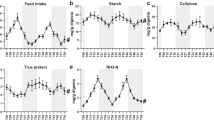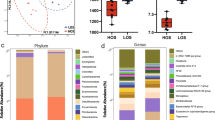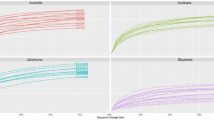Abstract
Alimentary carbohydrate overload is a significant cause of laminitis in horses and is correlated with drastic shifts in the composition of hindgut microbiota. Equine hindgut streptococcal species (EHSS), predominantly Streptococcus lutetiensis, have been shown to be the most common microorganisms culturable from the equine caecum prior to the onset of laminitis. However, the inherent biases of culture-based methods are estimated to preclude up to 70% of the normal caecal microbiota. The objective of this study was to evaluate bacterial population shifts occurring in the equine caecum throughout the course of oligofructose-induced laminitis using several culture-independent techniques and to correlate these with caecal lactate, volatile fatty acid and degrees of polymerization 3–7 fructo-oligosaccharide concentrations. Our data conclusively show that of the total microbiota present in the equine hindgut, the EHSS S. lutetiensis is the predominant microorganism that proliferates prior to the onset of laminitis, utilizing oligofructose to produce large quantities of lactate. Population shifts in lactobacilli and Escherichia coli subpopulations occur secondarily to the EHSS population shifts, thus confirming that lactobacilli and coliforms have no role in laminitis. A large, curved, Gram-negative rod previously observed during the early phases of laminitis induction was most closely related to the Anaerovibrio genus and most likely represents a new, yet to be cultured, genus and species. Correlation of fluorescence in situ hybridization and quantitative real-time PCR results provide evidence supporting the hypothesis that laminitis is associated with the death en masse and rapid cell lysis of EHSS. If EHSS are lysed, liberated cellular components may initiate laminitis.
Similar content being viewed by others
Log in or create a free account to read this content
Gain free access to this article, as well as selected content from this journal and more on nature.com
or
References
Al Jassim RA, Scott PT, Trebbin AL, Trott DJ, Pollitt CC . (2005). The genetic diversity of lactic acid producing bacteria in the equine gastrointestinal tract. FEMS Microbiol Lett 248: 75–81.
Amann RI . (1995). Fluorescently labelled, ribosomal-RNA-targeted oligonucleotide probes in the study of microbial ecology. Mol Ecol 4: 543–553.
Bartosch S, Fite A, Macfarlane GT, McMurdo ME . (2004). Characterization of bacterial communities in feces from healthy elderly volunteers and hospitalized elderly patients by using real-time PCR and effects of antibiotic treatment on the fecal microbiota. Appl Environ Microbiol 70: 3575–3581.
Berg EL, Fu CJ, Porter JH, Kerley MS . (2005). Fructooligosaccharide supplementation in the yearling horse: effects on fecal pH, microbial content, and volatile fatty acid concentrations. J Anim Sci 83: 1549–1553.
Beynen AC, Baas JC, Hoekemeijer PE, Kappert HJ, Bakker MH, Koopman JP et al. (2002). Faecal bacterial profile, nitrogen excretion and mineral absorption in healthy dogs fed supplemental oligofructose. J Anim Physiol Anim Nutr (Berl) 86: 298–305.
Bjornsson L, Hugenholtz P, Tyson GW, Blackall LL . (2002). Filamentous Chloroflexi (green non-sulfur bacteria) are abundant in wastewater treatment processes with biological nutrient removal. Microbiology 148: 2309–2318.
Cairns AJ, Longland AC . (1998). International Research Conference on Equine Laminitis. Dodson and Horrell: Stoneliegh, Warwickshire, England, pp 1–3.
Croser EL, Pollitt CC . (2006). 52nd Annual Convention of the American Association of Equine Practitioners. American Association of Equine Practitioners: San Antonio, TX, USA, pp 542–546.
Daims H, Bruhl A, Amann R, Schleifer KH, Wagner M . (1999). The domain-specific probe EUB338 is insufficient for the detection of all bacteria: development and evaluation of a more comprehensive probe set. Syst Appl Microbiol 22: 434–444.
Daly K, Stewart CS, Flint HJ, Shirazi-Beechey SP . (2001). Bacterial diversity within the equine large intestine as revealed by molecular analysis of cloned 16S rRNA genes. FEMS Microbiol Ecol 38: 141–151.
Ewaschuk JB, Zello GA, Naylor JM, Brocks DR . (2002). Metabolic acidosis: separation methods and biological relevance of organic acids and lactic acid enantiomers. J Chromatogr B Analyt Technol Biomed Life Sci 781: 39–56.
French KR, Pollitt CC . (2004). Equine laminitis: cleavage of laminin 5 associated with basement membrane dysadhesion. Equine Vet J 36: 242–247.
Garner HE, Coffman JR, Hahn AW, Hutcheson DP, Tumbleson ME . (1975). Equine laminitis of alimentary origin: an experimental model. Am J Vet Res 36: 441–444.
Golomidova A, Kulikov E, Isaeva A, Manykin A, Letarov A . (2007). The diversity of coliphages and coliforms in horse feces reveals a complex pattern of ecological interactions. Appl Environ Microbiol 73: 5975–5981.
Hugenholtz P, Tyson GW, Blackall LL . (2002). Design and evaluation of 16S rRNA-targeted oligonucleotide probes for fluorescence in situ hybridization. Methods Mol Biol 179: 29–42.
Hugenholtz P, Tyson GW, Webb RI, Wagner AM, Blackall LL . (2001). Investigation of candidate division TM7, a recently recognized major lineage of the domain bacteria with no known pure-culture representatives. Appl Environ Microbiol 67: 411–419.
Hussein HS, Vogedes LA, Fernandez GC, Frankeny RL . (2004). Effects of cereal grain supplementation on apparent digestibility of nutrients and concentrations of fermentation end-products in the feces and serum of horses consuming alfalfa cubes. J Anim Sci 82: 1986–1996.
Klieve AV, Hennessy D, Ouwerkerk D, Forster RJ, Mackie RI, Attwood GT . (2003). Establishing populations of Megasphaera elsdenii YE 34 and Butyrivibrio fibrisolvens YE 44 in the rumen of cattle fed high grain diets. J Appl Microbiol 95: 621–630.
Klieve AV, Hudman JF, Bauchop T . (1989). Inducible bacteriophages from ruminal bacteria. Appl Environ Microbiol 55: 1630–1634.
Klieve AV, O'Leary MN, McMillen L, Ouwerkerk D . (2007). Ruminococcus bromii, identification and isolation as a dominant community member in the rumen of cattle fed a barley diet. J Appl Microbiol 103: 2065–2073.
Kocherginskaya SA, Cann IKO, Mackie RI . (2005). Denaturing gradient gel electrophoresis. In: Makkar HPS, Mcsweeney CS (eds). Methods in Gut Microbial Ecology for Ruminants. International Atomic Energy Agency, Springer Academic Press: Dordrecht, Netherlands, pp 119–128.
Lane DJ . (1991). 16S/23S rRNA sequencing. In: Stackebrandt E, Goodfellow M (eds). Nucleic Acid Techniques in Bacterial Systematics. Wiley: New York, pp 115–175.
Longland AC, Byrd BM . (2006). Pasture nonstructural carbohydrates and equine laminitis. J Nutr 136: 2099S–2102S.
Macfarlane S, Macfarlane GT, Cummings JH . (2006). Review article: prebiotics in the gastrointestinal tract. Aliment Pharmacol Ther 24: 701–714.
Mackie RI, Wilkins CA . (1988). Enumeration of anaerobic bacterial microflora of the equine gastrointestinal tract. Appl Environ Microbiol 54: 2155–2160.
Milinovich GJ, Burrell PC, Pollitt CC, Bouvet A, Trott DJ . (2008). Streptococcus henryi sp. nov. and Streptococcus caballi sp. nov.: two novel streptococci isolated from the hindgut of horses with oligofructose-induced laminitis. Int J Syst Evol Microbiol 58: 262–266.
Milinovich GJ, Trott DJ, Burrell PC, Croser EL, Al Jassim RA, Morton JM et al. (2007). Fluorescence in situ hybridization analysis of hindgut bacteria associated with the development of equine laminitis. Environ Microbiol 9: 2090–2100.
Milinovich GJ, Trott DJ, Burrell PC, van Eps AW, Thoefner MB, Blackall LL et al. (2006). Changes in equine hindgut bacterial populations during oligofructose-induced laminitis. Environ Microbiol 8: 885–898.
Morita H, Shiratori C, Murakami M, Takami H, Kato Y, Endo A et al. (2007). Lactobacillus hayakitensis sp. nov., isolated from intestines of healthy thoroughbreds. Int J Syst Evol Microbiol 57: 2836–2839.
Morotomi M, Yuki N, Kado Y, Kushiro A, Shimazaki T, Watanabe K et al. (2002). Lactobacillus equi sp. nov., a predominant intestinal Lactobacillus species of the horse isolated from faeces of healthy horses. Int J Syst Evol Microbiol 52: 211–214.
Muyzer G, de Waal EC, Uitterlinden AG . (1993). Profiling of complex microbial populations by denaturing gradient gel electrophoresis analysis of polymerase chain reaction-amplified genes coding for 16S rRNA. Appl Environ Microbiol 59: 695–700.
Nadkarni MA, Martin FE, Jacques NA, Hunter N . (2002). Determination of bacterial load by real-time PCR using a broad-range (universal) probe and primers set. Microbiology 148: 257–266.
Nilsson U, Oste R, Jagerstad M, Birkhed D . (1988). Cereal fructans: in vitro and in vivo studies on availability in rats and humans. J Nutr 118: 1325–1330.
Ouwerkerk D, Klieve AV . (2001). Bacterial diversity within feedlot manure. Anaerobe 7: 59–66.
Ouwerkerk D, Klieve AV, Forster RJ . (2002). Enumeration of Megasphaera elsdenii in rumen contents by real-time Taq nuclease assay. J Appl Microbiol 92: 753–758.
Pollitt CC . (1999). 45th Annual convention of the American Association of Equine Practitioners. American Association of Equine Practitioners: Albuquerque, New Mexico, USA, pp 188–192.
Respondek F, Goachet AG, Julliand V . (2008). Effects of dietary short-chain fructooligosaccharides on the intestinal microflora of horses subjected to a sudden change in diet. J Anim Sci 86: 316–323.
Roberfroid MB, Delzenne NM . (1998). Dietary fructans. Annu Rev Nutr 18: 117–143.
Stahl DA, Amann RI . (1991). Development and application of nucleic acid probes. In: Stackebrandt E and Goodfellow M (eds). Nucleic Acid Techniques in Bacterial Systematics. Academic Press: Chicester, pp 205–248.
Stevenson DM, Weimer PJ . (2007). Dominance of Prevotella and low abundance of classical ruminal bacterial species in the bovine rumen revealed by relative quantification real-time PCR. Appl Microbiol Biotechnol 75: 165–174.
Tajima K, Aminov RI, Nagamine T, Matsui H, Nakamura M, Benno Y . (2001). Diet-dependent shifts in the bacterial population of the rumen revealed with real-time PCR. Appl Environ Microbiol 67: 2766–2774.
USDA (2000). Lameness and Laminitis in US Horses. USDA:APHIS:VS, CEAH, National Animal Health Monitoring System: Fort Collins, Colorado, USA.
van Eps AW, Pollitt CC . (2004). Equine laminitis: cryotherapy reduces the severity of the acute lesion. Equine Vet J 36: 255–260.
van Eps AW, Pollitt CC . (2006). Equine laminitis induced with oligofructose. Equine Vet J 38: 203–208.
Yu Z, Forster RJ . (2005). Nucleic acid extraction, oligonucleotide probes and PCR methods. In: Makkar HPS and Mcsweeney CS (eds). Methods in Gut Microbial Ecology for Ruminants. International Atomic Energy Agency, Springer Academic Press: Dortrecht, the Netherlands, pp 81–104.
Zoetendal EG, Cheng B, Koike S, Mackie RI . (2004). Molecular microbial ecology of the gastrointestinal tract: from phylogeny to function. Curr Issues Intest Microbiol 5: 31–47.
Acknowledgements
This project was supported by the Rural Industries Research and Development Corporation (RIRDC) of Australia and the Animal Health Foundation (AHF), St Louis, Missouri, USA. We thank Graham Kerven of The University of Queensland's School of Land, Crop and Food Science for chromatography assistance, Lester Walters and the staff of Eagle Farm Equine Hospital for performing the surgery to place the caecal fistulas in the animals used in this study, Elena Constantinoiu of The University of Queensland's School of Veterinary Science for assistance in processing of samples, Lyle McMillen of the Department of Primary Industries and Fisheries' Animal Research Institute for technical assistance with qPCR and Christopher Owens for monitoring of animals and collection of samples.
Author information
Authors and Affiliations
Corresponding author
Additional information
Supplementary Information accompanies the paper on The ISME Journal website (http://www.nature.com/ismej)
Rights and permissions
About this article
Cite this article
Milinovich, G., Burrell, P., Pollitt, C. et al. Microbial ecology of the equine hindgut during oligofructose-induced laminitis. ISME J 2, 1089–1100 (2008). https://doi.org/10.1038/ismej.2008.67
Received:
Revised:
Accepted:
Published:
Issue date:
DOI: https://doi.org/10.1038/ismej.2008.67
Keywords
This article is cited by
-
Chemical composition and physical characteristics of faeces in horses with and without free faecal liquid – two case-control studies
BMC Veterinary Research (2022)
-
Changes of microbial and metabolome of the equine hindgut during oligofructose-induced laminitis
BMC Veterinary Research (2021)
-
The gut microbiome of horses: current research on equine enteral microbiota and future perspectives
Animal Microbiome (2019)
-
Expression of immune regulatory genes correlate with the abundance of specific Clostridiales and Verrucomicrobia species in the equine ileum and cecum
Scientific Reports (2019)
-
High-starch diets alter equine faecal microbiota and increase behavioural reactivity
Scientific Reports (2019)



